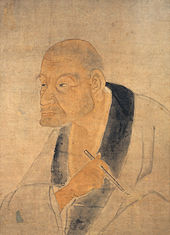Let's Fill eRep with Art Part 3
 •
by
•
by Anthony Colby
There has been an ongoing international series of articles about bringing art and artists into eRepublik. The original article was from Homer J Simpson in his paper The Muppet Show. He had the idea of bringing art into the eworld and brightening people's day, as well as introducing artists to our world.
Following is his introduction and explanation of the idea: The way this works is you comment and I give you an artist. You then publish an article with this explanation and an example of the given artist's work. You then do the same for people who comment on yours.
So having commented on Paddy O'Brien's latest article I was assigned the artist Kanō Tan'yū.
Kanō Tan'yū
Kanō Tan'yū (狩野 探幽?, 4 March 1602 – 4 November 1674) was one of the foremost Japanese painters of the Kanō school. His original given name was Morinobu; he was the eldest son of Kanō Takanobu and grandson of Kanō Eitoku. Many of the most famous and widely known Kanō works today are by Tan'yū.
In 1617, Tan'yū was appointed by the Tokugawa shogunate to become one of the shogunate's official artists. Over the following years, he was given many highly prestigious commissions. Over the 1620s and '30s, he created a number of large-scale works for Edo Castle, Nijō Castle, Osaka Castle, Nagoya Castle, and Nikkō Tōshō-gū.
Prolific in a variety of painting styles, Tan'yū's most famous works are probably those he produced for these large-scale commissions. They are screens and panels, prime examples of the Momoyama style, depicting natural subjects such as tigers, birds and plants, in bright colors and with extensive use of gold leaf. The gold, often used to represent clouds, water, or other background elements, would reflect what little light was available indoors, brightening a castle's dark rooms.
Tan'yū was also accomplished, however, in monochrome ink painting based on the prototypical style of the Muromachi period, yamato-e compositions in a style similar to that of the Tosa school, and Chinese style scrolls. His most famous yamato-e work is a narrative handscroll depicting the life of Tokugawa Ieyasu, the first Tokugawa shogun and major figure in Japanese history. It was after this commission, in 1640, that the artist first took on the "artist name" of Tan'yū.
In addition to being a highly honored and respected painter in his own right, Tan'yū was known as a collector and connoisseur of Chinese paintings. He made sketches and kept records of many of the paintings that passed through his studio, brought to him for authentication.


There are plenty of images of Kano art but not all were by Tan'yu. In Japanese culture the family name comes first so Kano style works are by a family with Tan'yu being the most famous member of the family.
Thanks for reading and viewing.
Anthony Colby


Comments
boated
You looking for an artist?
Nah... but I appreciate the offer.
v+
Would you like an artists to write an article about?
oh, thanks for the offer, but I don't know anything about painting 😁
lol That is what Wikipedia is for. Cut and paste man. Cut and paste.
Very nice 🙂
Want another one?
I think I can handle one more, after that it might be time for music, like you suggested to Daghda.
OK. Since the last person I assigned him to did not write an article. (At least I didn't see it if they did) How about Andrew Wyeth.
well done, AC,voted
How about you Dag. Want an artist?
tbh, i'm more into music than paintings. But thx for the offer, mate 🙂
Maybe we could start a music one. Either name a band, type of music or a year.